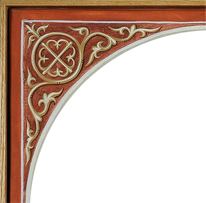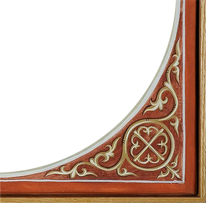'The life of believers contains in itself the mystery of Easter'. A reflection on the mystery of Christ's resurrection made alive in the heart of the faithful.
'The life of believers contains in itself the mystery of Easter'. So says St Leo the Great, Pope of Rome in the first half of the fifth century, in his Paschal homily at the Vigil of Holy Saturday. His words are captivating and inspiring, yet somehow mysterious, intimating a reality that we do not fully comprehend. Pascha exists in us, is alive in us, is realized in our very lives as Christian believers. Here is the mystery behind the Mystery. Somewhere, entwined with the thrall of our everyday existence, is the wonder of the Resurrection. The Paschal reality, says Leo, subsists in our own humble beings.
Can this be so? Can the greatest of all mysteries, the arch-wonder and the heart of the supreme Feast dwell in so frail a thing as our weak humanity? If the Christian community is awake to its own state of existence, the purity, unity, and ultimate sanctity of the Resurrection seem but a distant goal and a far cry from the reality of our present life. We are wont more readily to identify with the sentiment of Methodius of Olympus, who austerely portended, 'What a ship is to the land, that our present life is to that which is immortal' — the waywardness of our sinful existence is as unstable and ill-grounded before the divine life as the storm-tossed ocean before the land. It seems that especially before the holiness of Pascha, with its bright joy and radiant imagery of the victorious Lord, do we see with greater clarity our own great distance from His perfection. Can it be we who 'contain in ourselves' the mystery of Easter? Can it be our ship-like existence, tossed about from one storm to the next, that somehow shows forth the great rock of stability that is the risen Christ?
Not all men have thought so. It has been written by authors innumerable that Easter is of all things the furthest from human reality, the one great spiritual external by which the carnal person may be lifted out of his 'human' subsistence and into that of the divine. Just as the sea can never be the dry land, so can sinful humanity never be of the same mold as that perfect stability that was made wholly manifest at the Resurrection. How great the influence this view has had on the modern world, how much of modern Christian spirituality is founded upon its basic premise.
Yet it is not the voice of the Church, not the voice of the Fathers. From its earliest days, the Church has proclaimed the unfathomable mystery of Pascha not as an addition to or cover for weak humanity, but as a fundamental change in the very nature of what it means to be human—a new reality brought to life in a new man, and thence among all humankind through our rebirth in Christ. Yes, fallen humanity still exists, and still exists as fallen; but since the moment of the Resurrection this fallen humanity has existed in a manner never before known in the cosmos. Fallen humanity exists in deep, interior union with the God whom sin could not conquer, whom fallenness could not hold, whom death itself could not defeat. The Resurrection of Christ was not simply a reality 'for Him', but a reality for us through the fullness of His human nature. By His death and Resurrection, the very character of human existence was given new life.
Of this defining moment for the whole of mankind, Augustine of Hippo once wrote: 'On the third day He rose again from the dead, the first-begotten for brethren destined to come after Him, whom He has called into adoption as sons of God, whom also He has deemed it meet to make His own joint-partners and joint-heirs'. It is in Christ's Resurrection that human adoption into sonship with God is fulfilled, and this adoption was wrought precisely so that the true life of Christ might become the real and essential life of man. The Resurrection of the Son is the sign of the ultimate maturation, the full realization of human nature. Wrote the emperor Constantine, equal to the Apostles: 'No sooner had the radiance of the Savior’s presence appeared, than justice took the place of wrong, a calm succeeded the confusion of the storm, and the predictions of the prophets were all fulfilled'.
There is a beautiful, remarkably beautiful, depth to the inner reality which the Fathers connect to the Resurrection. Methodius likened the life of man to the voyage of a boat tossed about on a troubled sea; but we are reminded that we voyage through this life with Christ—Christ who walked on the sea, for whom the waters were as stable as dry land. We may be bound up in our sin, cast off like the prodigal who was not worthy even to be called a servant; but Christ's Incarnation and Resurrection were wrought for our adoption unto God not as slaves, but as sons and daughters. Methodius knew that, in the risen Christ, the ship of human existence had found a new pilot. 'Whence also the Word descended into our world, and was incarnate of our body, in order that, having fashioned it into a more divine image, He might raise it incorrupt, although it has been dissolved by time'
And so we return to that small phrase of St Leo of Rome: 'The life of believers contains in itself the mystery of Easter'. Whence this mystery that we proclaim? In the Resurrection of the Son of God. How is it proclaimed in us? By the new life we are given as sons and daughters of the Father, brethren and friends of the Incarnate Word through the working of His Spirit—by the fact that, through the dark reality of our sinfulness, our brokenness and our disunity, through all these things God works in us a union with Himself that brings the ill to good health and the dead to life. The very fact that our sin has not swallowed us, that death has not claimed us rightly as its captive foe, is a wonderful sign that something greater lives in us. That we live in spite of our sin reveals the Paschal reality that a power greater than death reigns in our bodies and a grace more powerful than evil has hold on our lives. The life of the faithful is the mystery of the Resurrection, for without the Resurrection, we would have no life at all. Daily existence in the face of sin, in the face of human fallenness, is nothing less than the miracle of Pascha continued.
For this reason, then, the reality of Pascha must be alive in our hearts and minds each day, not solely at the moment of this great Feast of feasts. The life of the Christian faithful is a Paschal life, a life of daily resurrection, a life of daily mystery. Though this mystery is celebrated most potently in the heart of that night which Fr Alexander Schmemann called 'brighter than the day', it is a mystery that is to be lived at every hour, at every moment, in every place and circumstance. Nowhere are we reminded of this charge more directly than in the words of our same Father Leo: “These thoughts, dearly beloved, must be kept in mind not only for the Easter festival, but also for the sanctification of the whole life, and to this our present exercise ought to be directed, that what has delighted the souls of the faithful by the experience of a short observance may pass into a habit and remain unalterably, and if any fault creep in, it may be destroyed by speedy repentance. And because the cure of old-standing diseases is slow and difficult, remedies should be applied early, when the wounds are fresh, so that rising ever anew from all downfalls, we may deserve to attain to the incorruptible Resurrection of our glorified flesh in Christ Jesus our Lord, who lives and reigns with the Father and the Holy Spirit for ever and ever. Amen.”



